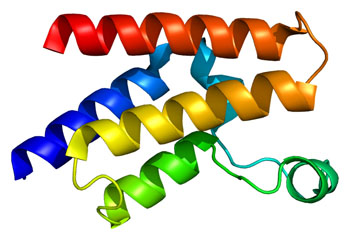CRISPR/Cas9 Identifies Potential Drug Target in Acute Myeloid Leukemia
By LabMedica International staff writers
Posted on 27 Oct 2016
The CRISPR/Cas9 genome editing technique was modified to identify genes critical for the survival and growth of acute myeloid leukemia (AML) cancer cells.Posted on 27 Oct 2016
AML is a cancer of the myeloid line of blood cells, characterized by the rapid growth of abnormal white blood cells that accumulate in the bone marrow and interfere with the production of normal blood cells. The symptoms of AML are caused by replacement of normal bone marrow with leukemic cells, which causes a drop in red blood cells, platelets, and normal white blood cells. Symptoms include fatigue, shortness of breath, easy bruising and bleeding, and increased risk of infection. AML progresses rapidly and is typically fatal within weeks or months if left untreated.

Image: Molecular model of the enzyme encoded by the KAT2A gene (Photo courtesy of Wikimedia Commons).
To identify additional therapeutic targets in AML, investigators at the Wellcome Trust Sanger Institute (London, United Kingdom) optimized a genome-wide clustered regularly interspaced short palindromic repeats (CRISPR) screening platform and used it to identify genetic vulnerabilities in AML cells.
CRISPRs (clustered regularly interspaced short palindromic repeats) are segments of prokaryotic DNA containing short repetitions of base sequences. Each repetition is followed by short segments of "spacer DNA" from previous exposures to a bacterial virus or plasmid. CRISPRs are found in approximately 40% of sequenced bacteria genomes and 90% of sequenced archaea. CRISPRs are often associated with cas genes that code for proteins related to CRISPRs. Since 2013, the CRISPR/Cas system has been used in research for gene editing (adding, disrupting, or changing the sequence of specific genes) and gene regulation. By delivering the Cas9 enzyme and appropriate guide RNAs (sgRNAs) into a cell, the organism's genome can be cut at any desired location. The conventional CRISPR/Cas9 system is composed of two parts: the Cas9 enzyme, which cleaves the DNA molecule and specific RNA guides that shepherd the Cas9 protein to the target gene on a DNA strand.
The investigators used CRISPR/Cas 9 to catalogue approximately 500 genes that were essential for cancer cell survival, including more than 200 genes for which drugs could be designed. They focused their attention on the KAT2A gene as a candidate for downstream study. They reported in the October 18, 2016, online edition of the journal Cell Reports that KAT2A inhibition demonstrated anti-AML activity by inducing myeloid differentiation and apoptosis, and suppressed the growth of primary human AMLs of diverse genotypes while sparing normal hemopoietic stem-progenitor cells.
Senior author Dr. Kosuke Yusa, joint project leader at the Sanger Institute, said, "Previous studies showed proof of principle, but this is one of the first systematic attempts to identify the genetic vulnerabilities of AML. We have improved and applied CRISPR-Cas 9 technology to look at what actually kills cells. CRISPR is becoming a powerful technique in cancer research because it overcomes some of the limitations of earlier tools."
Related Links:
Wellcome Trust Sanger Institute







 assay.jpg)





